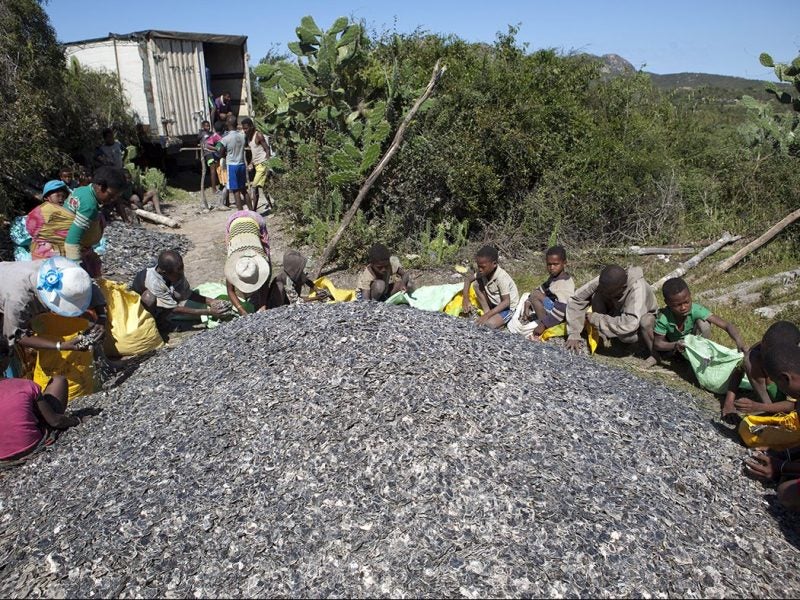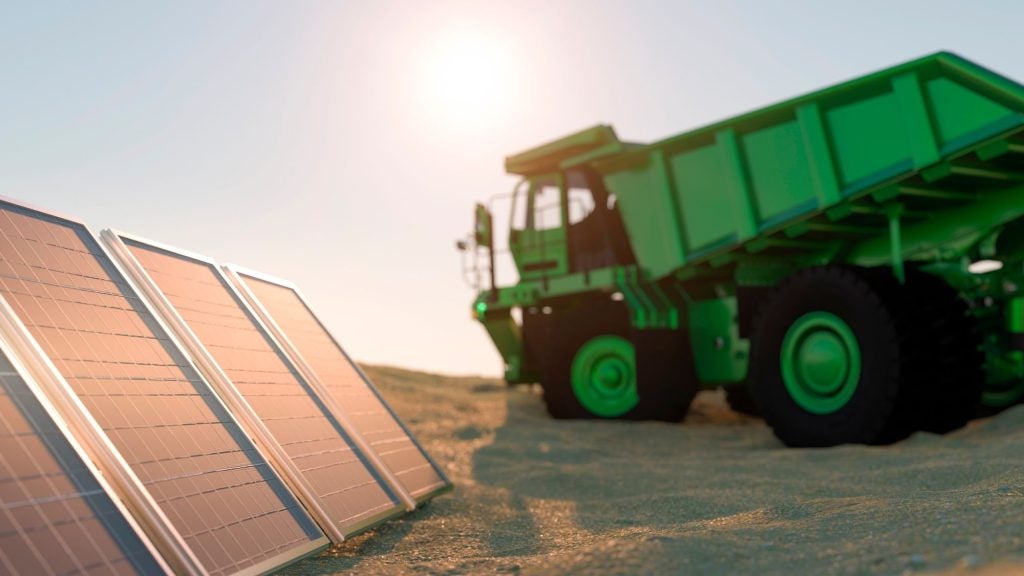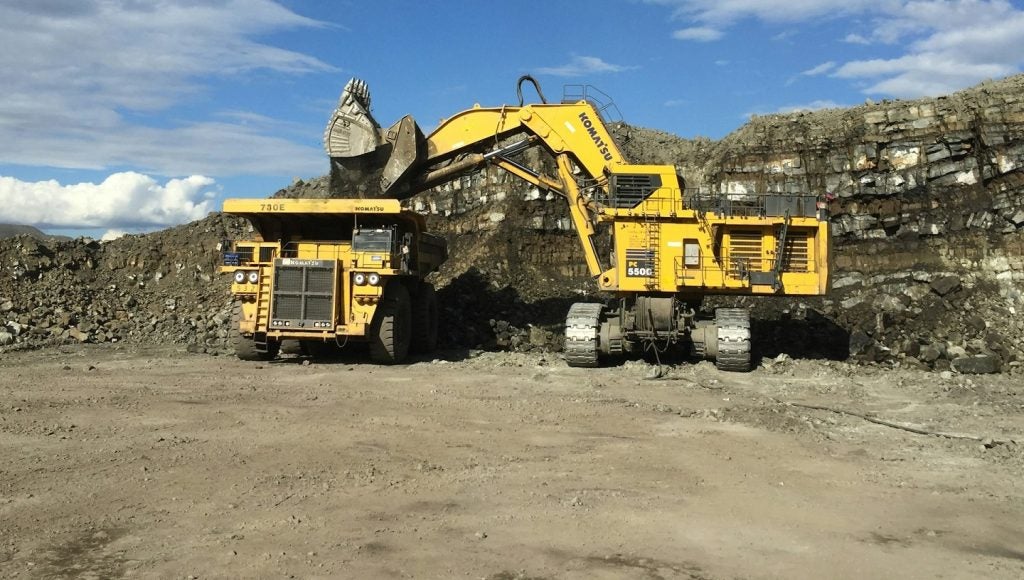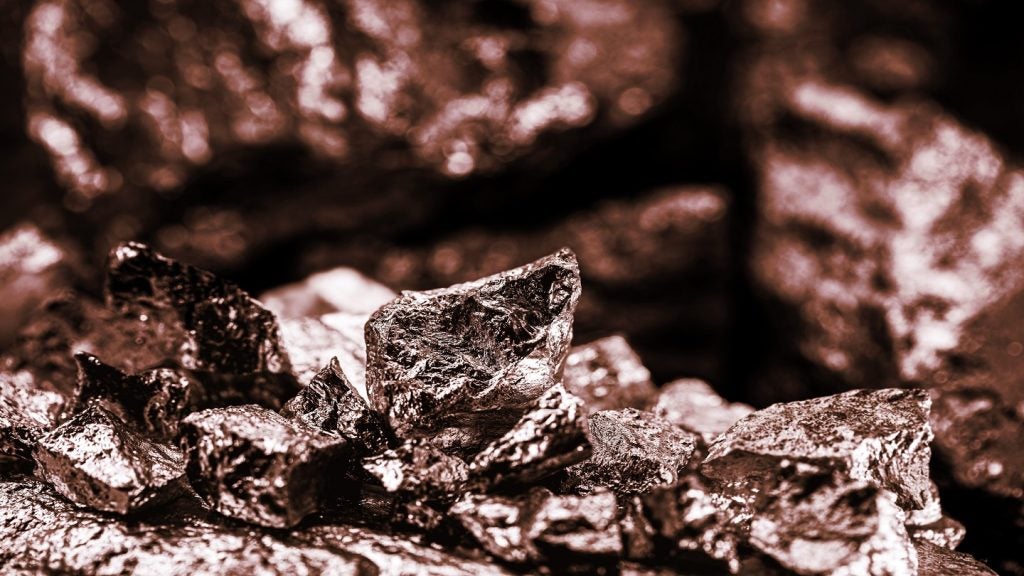
Eight-year-old Frederic works morning or afternoon shifts, depending on his school schedule, sorting mica alongside his elder brother. His hands are marked by traces, wounds and scars caused by the repetitive task of removing the calcite.
Thirteen-year-old Felicia, who has never attended school, works Monday to Sunday for a sorting company. The money she earns helps support her mother and eight siblings, but is having a negative impact on her health.
These are just two stories of child labour in the illegal mica mining sector of Madagascar detailed by a new report by NGOs Terre des Hommes and SOMO.
Researchers from the organisations found that, despite ongoing initiatives, entire families are routinely working in the extraction and processing of the mica, which can be found in hundreds of Western products. Overall, they cautiously estimate that around 22,000 people work in the informal sector in Madagascar, of which at least half are minors.
Digging for mica
Mica is the name for a group of different minerals that form in distinct layers. The commodity is particularly coveted for its heat resistant and highly reflective properties and can be found in everything from paints to soil conditioners to make-up and smartphones.
The mineral is produced predominately in China, and then India, but the East African island of Madagascar has become a notable source in recent years.
How well do you really know your competitors?
Access the most comprehensive Company Profiles on the market, powered by GlobalData. Save hours of research. Gain competitive edge.

Thank you!
Your download email will arrive shortly
Not ready to buy yet? Download a free sample
We are confident about the unique quality of our Company Profiles. However, we want you to make the most beneficial decision for your business, so we offer a free sample that you can download by submitting the below form
By GlobalDataThe country was the fourth largest mica exporter worldwide in 2015, and since then it has overtaken India as the biggest global exporter of sheet mica, the grade of mica that is used extensively in the electronics and automotive industries.
Madagascar has among the highest poverty rates in the world and informal mining of mica has become a life-line for many.
“In these remote areas where mica mining takes place, many children lack education [or] social services and there are weak local institutions; often mining is a family affair, as it’s where the sole income is derived,” says Claire van Bekkum, a senior project manager at Terre des Hommes Netherlands.
Mining the mineral involves dangerous digging of vertical shafts of one to two metres wide and around 15 metres deep, extracting and then sorting the mica.
Once extracted and sorted, the commodity is exported primarily to China. From there it finds its way into Western products.
Ending child labour
Poverty is the key driver in child exploitation and illegal mining of mica in Madagascar and also India, but it requires a multi-stakeholder response to eliminate, including action from the private sector, communities and government, says van Bekkum.
“It can start with companies taking responsibility by thoroughly doing their due diligence and looking beyond tier one and tier two to further down their supply chain,” she says.
While awareness about child labour used in mica production is growing, thanks to the work of NGOs such as Terre des Hommes and the Responsible Mica Initiative (RMI), a global ‘do-tank’, companies have often been ignorant about the mineral and its origins.
For example, van Bekkum has spoken to some that were completely unaware mica is used in their products.
To keep up to date on the issues and to be part of the solution, firms with mica in their supply chain should join and support the RMI, and invest in NGOs that are trying to tackle and raise awareness of the problems, she says.
“Companies can really make sure suppliers clean up their supply and governments take action,” she adds.
Some sectors, such as the cosmetics industry however, which uses a very small amount of mica to achieve the shimmer in their products, have been proactive in engaging with NGOs and RMI.
However, others such as the automotive and electronic sectors, which are the biggest uses of mica, have shown little interest, with the exception of German carmaker Daimler, which is working with Terre des Hommes. In June 2018, the company, which owns Mercedes-Benz, announced it would increase the checks on the products it uses to avoid using mica mined in unregulated conditions by children.
China’s role in the mica trade
Nearly all mica products pass through China, which also presents a challenge for those conducting due diligence. According to the report, 87% of Madagascan mica goes to China by ship and then ends up in products from companies such as Japan’s Panasonic and Fujikura, European Prysmian Group, Swiss-based Van Roll and Isovolta.
“Companies in China importing mica should also do their due diligence and make sure they are using legal mica,” says van Bekkum. “However, China is not a front runner in this respect and this is an issue for companies further downstream, making it more difficult to check their supply chains, but still they should be trying and putting on the pressure.”
Despite the complexity and opaqueness of the mica supply chain, van Bekkum is keen to stress that firms shouldn’t boycott the mineral altogether. This would have a devastating impact on the mica mining communities because it is often their only source of income.
Paying more for the mineral, however, could be part of the solution. The floor price of four euro cents per kilo means there is serious exploitation of the mica workers, according to the report.
“The communities need to understand their bargaining power and we also need to consider the many middlemen that are in the supply chain and how they can really bargain for better pay,” says van Bekkum.
Informal small-scale miners in South America have had some success in this regard, by working together and forming cooperatives.
Ongoing developments from the Netherlands to India
Progress to tackle the problem is slow. In north-east India, where child labour in the mica industry has been on the radar of the cosmetics industry for around 10 years, the government did decide to formalise the mines with licences in a bid to stamp out child labour and poor conditions. However, van Bekkum says although action to do this is happening, it is very slow moving.
In the international community, RMI and the Responsible Minerals Initiative, an Initiative of the Responsible Business Alliance, have signed a Memorandum of Understanding to work toward ending the use of child labour and to improve working conditions in mica industry supply chains globally.
The Netherlands has also committed to implement its Child Labor Due Diligence Act, which will require supply chain due diligence and reporting by a significant number of foreign-based multinationals providing goods or services in the country. It comes into force in 2022. However, wider Europe is slow to act, says van Bekkum.
More needs to be done, especially from governments and the business community, particularly the automotive and electronics sector.
“They need to be part of the multi-stakeholder approaches – companies do have a role but the question is, will they take it up?”
They, of course, should. And there is increasing pressure to, not just from NGOs, but from a legal standpoint, as a recent lawsuit against Apple, Google, Dell, Microsoft and Tesla shows. The companies are being sued by Congolese families who say their children were killed or maimed while mining for cobalt used in smart phones.
This type of law suit is being brought against big western companies who do not source minerals responsibly more and more often. It may only be a matter of time until major mica users are brought to task.






